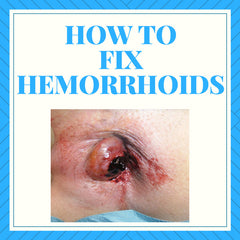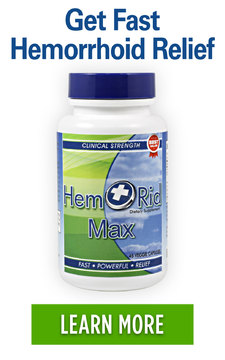How to Fix Hemorrhoids Fast, Naturally and Safely - External, Internal, Prolapsed & Thrombosed
Posted on 09 May 2018 by Maryanne Johnson
Share this post
Want to know how to fix hemorrhoids fast? In this post, we will share how to fix internal, external, thrombosed and prolapsed hemorrhoids. We'll discuss how to do so quickly and in a natural, safe way.
Hemorrhoids are a common issue that almost half of the population of older Americans experience on a day-to-day basis.
Table of Contents [hide]
- 1. How to Fix Hemorrhoids
- 2. How to Fix Hemorrhoids at Home
- 3. How to Fix External Hemorrhoids
- 4. How to Fix Internal Hemorrhoids
- 5. How to Fix Bleeding Hemorrhoids
- 6. How to Fix Prolapsed (Protruding) Hemorrhoids
- 7. Best Fix for Hemorrhoids
- 8. What Type of Doctor Fixes Hemorrhoids?
- 9. How to Fix Hemorrhoids After Pregnancy
- 10. Conclusion
These veins in our lower rectal area and around our anal area sometimes become swollen and irritated.
This inflammation gives us symptoms of pain, discomfort, an inability to sit or stand for long periods of time, rectal bleeding, anal itching, and other embarrassing problems.
How to Fix Hemorrhoids
Hemorrhoids are uncomfortable to have and equally uncomfortable to talk about.
The four different kinds of hemorrhoids include:
Hemorrhoid symptoms can often dictate our lifestyles and even make trips to the bathroom harder than they should be.
If you are experiencing these problems with hemorrhoids, it is not the end of the world. There are many different remedies you can try for each type of hemorrhoid.
How to Fix Hemorrhoids at Home
Hemorrhoids can be considered an embarrassing problem. Fortunately, there are methods you can do in the comfort of your own home to help subside and alleviate these symptoms.
From wipes to ointments, there are many ways to help treat hemorrhoids. There are two types of hemorrhoids, internal and external, and the treatments for both vary.
Internal hemorrhoids can become prolapsed, or fall out of the anus. External hemorrhoids can thrombose, or form a blood clot.
And while you can do at-home treatments, you can also take solace in the fact that hemorrhoids can usually go away on their own within a few days or a few weeks.
However, they do not always go away. Plus, getting hemorrhoid pain relief can really improve your life.
If you think you are experiencing hemorrhoids, consult your doctor, especially if one of the symptoms is rectal bleeding.
Hemorrhoid doctors are usually called gastroenterologists or proctologists.
While rectal bleeding may be a result of the very common condition of hemorrhoids, your body might be telling you it’s a derivative of a separate rectal condition.
How to Fix External Hemorrhoids
The more painful of the two types of hemorrhoids, external hemorrhoids are small, rubbery bumps that form around the anal area.
They take formation when the veins underneath the skin in this area become irritated and inflame.
To fix external hemorrhoids, topical methods of treatment can be applied to these bumps to help encourage them to shrink.
Creams are one of the easiest ways to treat external hemorrhoids. Our best hemorrhoid cream guide can help you determine which cream you should pick.
Try an over the counter cream like Preparation H, which is formulated for hemorrhoids specifically, and can help reduce swelling and inflammation.
Hemorrhoid creams leave a soothing, calming effect on the external hemorrhoids, which can help alleviate the pain that they often cause.
Another method to fix external hemorrhoids is a sitz bath.
Taking a sitz bath where you submerge your anal area in warm water is proven to be effective. Not only does this method offer relief of the pain brought on by external hemorrhoids, but also keeps this area clean, and this is important in order to shrink your hemorrhoids.
You can find sitz baths at your local health care store. Some of these sitz baths are designed to fit over the toilet bowl. Using a regular sized tub is just as effective, as well.
How to Fix Internal Hemorrhoids
Internal hemorrhoids are hard to detect and you almost never feel them unless they become prolapsed.
If you see blood after a bowel movement, either coating the stool or when you go to wipe, you likely have internal hemorrhoids.
Fixing internal hemorrhoids is trickier than fixing the other type, external hemorrhoids, as you cannot exactly apply ointments or use wipes directly on them.
A combination of both fiber and water is one of the best ways to shrink your internal hemorrhoids.
The softer you are able to make your stools, the lower risk you have when it comes to inflicting irritation to these sensitive veins.
Stools will retain the water you put into your body while the fiber will help push the food waste through without causing straining during a bowel movement.
How to Fix Bleeding Hemorrhoids
Bleeding hemorrhoids may refer to the formation of the blood clot inside of an external hemorrhoid.
If you notice that these bumps on the outside of your anal area become bluish or purple in color, you might be experiencing a thrombosed hemorrhoid.
To fix bleeding hemorrhoids, do not try to lance open the blood clot, however tempting it may be. If you cut open a blood clot, you are increasing your chance of contracting an infection to this area.
Instead, use wipes and ointments to encourage shrinking. Blood clots can go away on their own, and if they do not do this in a few days, it is best to consult your doctor about needing to lance and drain them.
Other bleeding hemorrhoids may refer to internal hemorrhoids. This type of hemorrhoid is known to produce rectal bleeding after a bowel movement.
As we discussed earlier, the best ways to reduce rectal bleeding and your internal hemorrhoids is to utilize a high fiber diet and drink plenty of water.
How to Fix Prolapsed (Protruding) Hemorrhoids
Sometimes, an internal hemorrhoid can become prolapsed. This means that the hemorrhoid falls through the anal opening. While this can be scary when it occurs, know that you are able to gently push this hemorrhoid back inside with your fingers.
Keep in mind that a prolapsed hemorrhoid can go inside the rectum again on its own. If you have a prolapsed hemorrhoid, the best fix is to let your doctor know.
While hemorrhoids can be irritating, there are plenty of remedies you can use at home to relieve the frustrating and painful symptoms.
Wondering how to stop hemorrhoid itching and burning? Check out our full guide here.
Best Fix for Hemorrhoids
Some of the best fixes for hemorrhoids are over the counter products that target different the symptoms you might experience.
Here are a few remedies you can try to relieve hemorrhoid symptoms until they shrink on their own:
- Sitz bath: This method has proven its effectiveness time and time again. Soaking your lower area that is concentrated with irritating hemorrhoids can immediately relieve symptoms.
- Hemorrhoid Creams: There are plenty of options for hemorrhoid creams, but try to use one that has anti-inflammatory properties, or uses the ingredient hydrocortisone.
- Hemorrhoid wipes: Wipes that have cooling and anti-inflammatory agents in their formula are excellent to help you keep clean without causing irritating, with a bonus of soothing relief for any itching or burning symptoms you may have.
- Hemorrhoid Suppositories: Suppositories are great for providing relief from hemorrhoids. They reach areas that creams and wipes cannot reach. If your hemorrhoids are bugging you, try suppositories!
What Type of Doctor Fixes Hemorrhoids?
While your family physician is most certainly qualified to treat hemorrhoid issues, a gastroenterologist has received years of training in disorders of the intestines, rectum, and anus.
If you have persistent and chronic hemorrhoids, your family doctor may recommend you to a gastroenterologist for further treatment.
Gastroenterologists are skilled in diagnosis and non-operative procedures, like rubber band ligation or sclerotherapy.
A gastroenterologist will send you to a proctologist if operative surgery is needed for your hemorrhoids.
For invasive hemorrhoid surgery, a proctologist takes over. A proctologist is well trained in operations concerning the intestine, rectum, and anus, and unlike a gastroenterologist, performs surgeries.
How to Fix Hemorrhoids After Pregnancy
Pregnancy and delivery can bring bouts of painful hemorrhoids, but fortunately, there are plenty of ways to treat them afterward. Hemorrhoids are often at their worst after birth, especially vaginal delivery, due to all the straining, pushing, and an abnormal amount of stress on the lower rectal area.
To get your body back on track after pregnancy sans painful hemorrhoids, try including more fiber or fiber supplements in your diet.
Pregnancy can cause episodes of chronic constipation that may not subside right after giving birth, so including fiber in your diet can boost bowel movements, and can, in turn, prevent hemorrhoids from becoming inflamed.
For external hemorrhoids that may have formed during or right after pregnancy, use these methods to encourage them to heal:
- Creams
- Ointments
- Warm baths
- Wipes
- Essential Oils
Conclusion
Hopefully, you will get relief from these treatment methods. You should consult your doctor for any medical advice regarding hemorrhoids.
Your doctor might want to proceed with additional examinations or have prescription treatment methods that are more effective.






0 comments